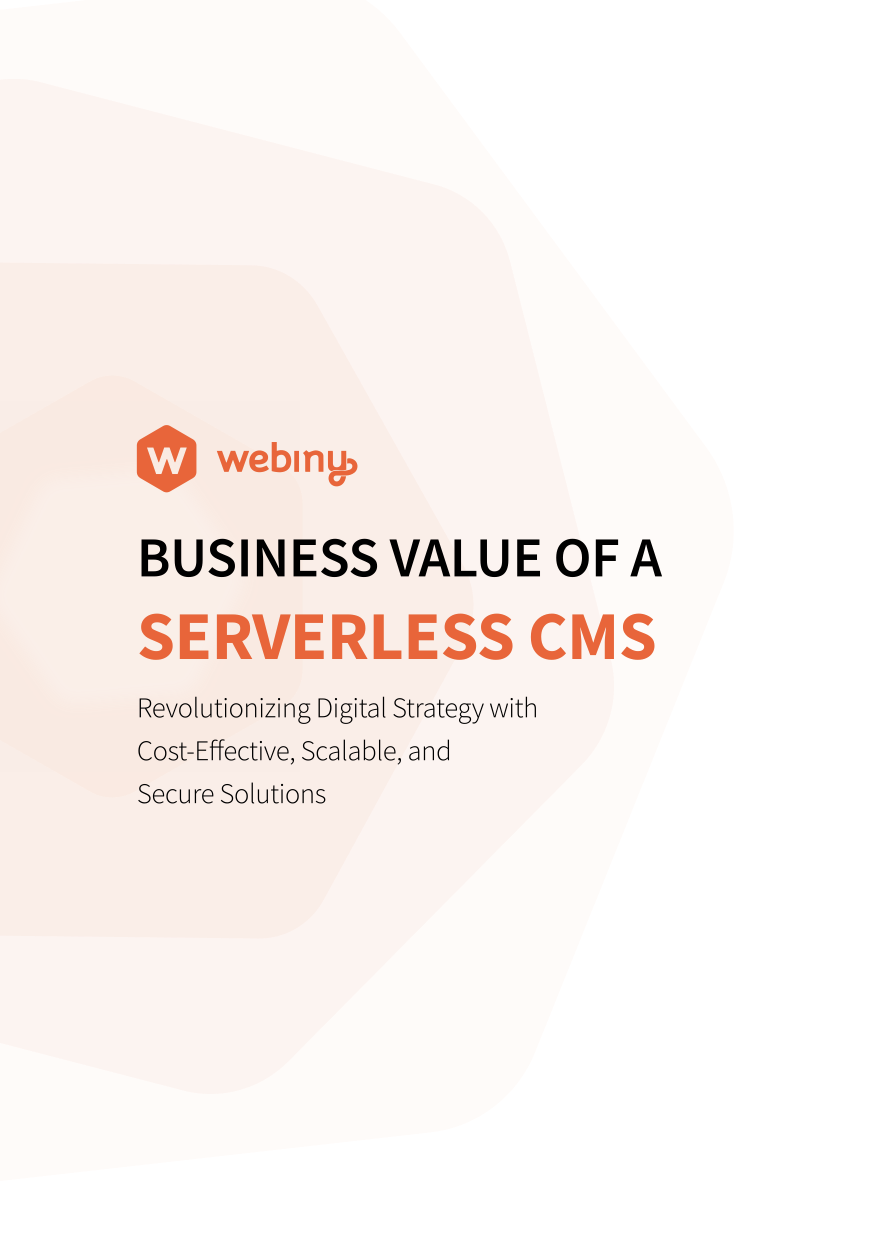The digital world has seen a significant evolution in recent years. Today, customers demand a seamless experience, whether they engage with a business via a website, a mobile app, a conversational interface, or a kiosk.
To ensure consistency across various touchpoints, businesses need a reliable Content Management System (CMS) as the backbone of their online presence. The right CMS can streamline content creation, personalise customer interactions, enhance productivity, manage a vast array of content types, and facilitate omnichannel delivery.
In this article, we will guide you through the intricate process of choosing the ideal CMS for your personalised business needs. We will discuss the different types of CMSs, highlight the advantages of headless CMSs – like Webiny – and share a checklist to help you make an informed choice.
Understanding an Enterprise CMS – What Is It?
An enterprise CMS is a specialised content management system designed to tackle large-scale organisations' complex content management needs. They are architected to handle large content volumes, fine-tuned for enterprise-grade performance, hardened using the most stringent security controls, and optimised to facilitate collaboration across cross-functional teams.
For example, a major financial organisation may use an enterprise CMS to manage compliance documentation and create personalised customer communications. Similarly, a large news organisation may use it to manage its expansive content libraries and deliver personalised news experiences across multiple channels.
While traditional enterprise CMSs have served businesses well for years, they struggle to address the evolving needs of the digital landscape. Their tightly coupled, monolithic architecture limits their ability to adapt to emerging customer touchpoints without significant reengineering seamlessly.
This is where headless CMSs, like Webiny, come into the picture. They introduce a new paradigm by decoupling the CMS backend from its frontend(s). This flexibility empowers businesses to deliver content to evolving digital touchpoints with unparalleled ease – more on this later.
The Need for Enterprise CMS in Modern Businesses
Enterprises typically manage large volumes of content that may exist in silos across different teams and functions. An enterprise CMS breaks these information silos and provides cross-functional teams with a centralised, intuitive interface for content management. This fosters collaboration and efficiency.
Moreover, an enterprise CMS is central to aligning digital initiatives with overarching business objectives. It enables companies to consistently deliver targeted content, quickly adapt to market changes and customer needs, and embrace new technologies.
Furthermore, enterprise CMSs are built upon robust, resilient infrastructures that deliver high-performance levels, scalability, and fault tolerance. They offer several crucial features out-of-the-box, including localisation, workflows, collaborative editing, and digital asset management.
Headless Enterprise CMS as an Alternative to Traditional Enterprise CMS
Traditional enterprise CMSs have several inherent limitations:
- The backend and frontend layers are inseparably intertwined. It’s hard, if not impossible, to make the traditional backend serve content to multiple frontend
- Your marketers and developers find it hard to function independently. Traditional enterprise CMSs typically lack a no-code solution to build dynamic page layouts
- Customizing traditional enterprise CMS solutions is often challenging. Many traditional enterprise CMSs are considered black boxes where making changes to their source code to add new features or to meet specific needs is not an option.
- Traditional CMS platforms often lack the agility and speed required to meet modern user expectations. Their monolithic architecture causes the intensive backend processing to occur within the same application as the frontend rendering. This can lead to slow-loading pages
Headless CMSs have been specifically designed to overcome these challenges.
Enter Headless CMSs
A Headless CMS separates the content management backend layer (where content is created and stored) from the frontend presentation layer (where content is displayed to users). The two layers communicate via APIs. This decoupling means the content can be managed independently of how and where it's delivered.
The fundamental difference lies in their architecture: a traditional CMS tightly couples the backend and front end, while a headless CMS separates them. Traditional CMSs provide an all-in-one solution with built-in themes and structures for content display. In contrast, Headless CMSs mainly focus on content modelling, creation, and storage, leaving the presentation flexibility to developers.
Benefits of a Headless CMS
A headless CMS promises several tangible benefits for enterprises, including:
Built for Omnichannel
A headless CMS is a backend-only solution capable of simultaneously integrating with several frontends. This allows enterprises to build a centralised content repository to deliver content to all customer touchpoints, including websites, smartphone apps, social media platforms, and IoT devices.
Unparalleled Customizability
Customization is a crucial factor for enterprise CMSs, as each enterprise has specific content management needs. With a variety of open-source headless CMSs in the market, you can unlock unparalleled customizability and can make changes to the source code to add new features or meet specific needs.
Enhanced Productivity
Headless enterprise CMSs empower marketers, content creators, and developers to work independently and efficiently. Marketers can focus on crafting engaging and intuitive pages, content creators can curate without worrying about the presentation, and developers get plenty of free time to work on improving the responsiveness and performance of the applications.
Better Speed and Performance
In a headless CMS setup, the intensive backend processing happens within the backend instance, whereas the frontend rendering occurs separately in the decoupled frontend application. This separation results in quicker load times than traditional CMSs, where a single monolithic application manages backend processing and frontend rendering.
Developer-Friendliness
Headless enterprise CMSs are designed with developers in mind. The API-first model means developers can use any programming language or framework to build the front end, including React, Next, Angular, Gatsby, and Vue. Moreover, they also support modern development paradigms, like webhooks and serverless architectures.
Key Factors to Consider When Choosing a Headless Enterprise CMS
There are several factors to consider when evaluating a headless enterprise CMS for your business. Each factor determines how well the CMS integrates into your workflows, supports growth, and safeguards your content. In the following sections, we will delve into these considerations.
Scalability
A headless CMS should seamlessly accommodate growing content volumes, traffic spikes, and evolving business needs. Regardless of whether it’s a self-hosted or a fully-managed solution, it should have a scalable architecture. An example of such a CMS is Webiny, which uses a serverless architecture to dynamically scale up or down as needed.
Security
Security is a non-negotiable aspect of a modern-day enterprise headless CMS. As enterprises often manage vast amounts of sensitive data, including customer information, intellectual property, and proprietary content, choosing a CMS that offers robust security measures is crucial.
Some features to look out for are:
- Encryption at rest and in transit
- Role-based access controls
- Regular updates (for vulnerabilities and bugs)
- Industry-standard protocols like OAuth and JWT for authentication
User Experience
A user-friendly CMS is essential for efficient content creation, management, and collaboration.
Look for features that simplify daily tasks for developers, marketers, and content creators alike. For example, your headless CMS should offer starter kits for developers to kick-start the development process. Marketers benefit from a drag-and-drop interface to craft dynamic, reusable components. For content creators, it should offer the ability to customise the editing interface.
Customisation and Integrations
Flexibility and interoperability are crucial factors when choosing a headless enterprise CMS. Beyond just customisable frontends, a robust headless CMS allows fine-tuning of backend functions. For example, you should be able to define custom types and fields and easily integrate with external systems using APIs or webhooks. Moreover, the chosen CMS should have a mature marketplace with several plugins and apps to enhance its functionality further.
Data Query and Content Modelling
The ability to effectively query and model data is essential for managing complex content structures and delivering personalised experiences.
The chosen enterprise CMS should allow you to define a granular and composable content model that fosters reusability and dynamism. It should also provide support for programmatic content modelling. For data querying, it should expose a GraphQL API with built-in support for filtering, ordering, sorting, and paginating data.
Open-Source
Open-source CMSs are generally the better choice for enterprises, offering complete transparency, customizability, and cost-effectiveness. Since you have direct access to the source code, you can tweak any aspect of the CMS backend or user interface to match your unique needs.
One headless enterprise CMS that excels in this regard is Webiny, whose source code is available under the MIT licence.
Spotlight on Webiny – a Leading Headless CMS Option
There are several headless CMS options available today, each boasting unique strengths, yet very few manage to deliver across all crucial aspects outlined above. Take Contentful, for instance, renowned for its mature ecosystem and on-demand scalability but constrained by its limited customizability.
On the other hand, Strapi, being open-source, offers unlimited customizability but falls short in providing enterprise-grade security and scalability.
Sanity, another prominent name, offers an enterprise-ready solution with powerful data querying capabilities but is closed-source.
Enter Webiny – one of the few – if not the only – solution that fully meets the multifaceted criteria for the ideal enterprise CMS. It combines the best features of the leading headless CMSs and includes a few unique and useful offerings of its own. The result is a scalable, performant, customisable, interoperable, and secure headless CMS tailor-made for modern enterprises.
Webiny is open-source like Strapi. As Webiny is built on highly scalable, fault-tolerant serverless services, it provides unparalleled scalability, reliability, & cost-efficiency. It’s enterprise-ready like Sanity, yet comes with an open-source code base available on GitHub. Here are a few reasons why it may be the ideal CMS for your organisation.
It’s Self-Hosted
Most enterprise headless CMSs are optimised to run within the vendors’ dedicated data centres. Webiny, however, is designed to be deployed inside your own AWS environment. This allows you to enforce your own security protocols, have complete visibility into your infrastructure, and seamlessly integrate with other AWS offerings, like S3 buckets and RDS databases.
It Runs on a Serverless Foundation
Webiny is built on top of highly scalable fault-tolerant AWS serverless services. With Webiny's serverless architecture, you can experience unparalleled scalability, reliability, and cost-efficiency.
It’s Open-Source Under the MIT Licence
Webiny is an open-source software, meaning your developers can adapt or change any part of the front or backend. Whether it's a minor tweak like a button on the interface or a significant overhaul like rewriting the content modelling architecture, Webiny offers you the flexibility to do it.
It Delivers 60-80% Cost Savings
Webiny’s serverless foundation saves up to 80% in infrastructure costs compared to VM-based deployments. Additionally, with no servers to manage, you can expect a reduction of up to 60% in DevOps-related expenses.
It Offers Enterprise-Grade Security
Despite being a self-hosted solution, Webiny takes numerous steps to uphold high levels of security. This is due to:
- The codebase and Webiny’s third-party dependencies are regularly scanned for vulnerabilities and security gaps
- Data is encrypted inside both DynamoDB and Elasticsearch to reduce the chances of exposure
- You can deploy Webiny inside an Amazon Virtual Private Cloud (VPC)
- Webiny uses AWS Cognito for authentication by default. You can also integrate with an external identity provider, like Okta or Auth0
Conclusion
Choosing the right enterprise CMS is crucial for a seamless digital experience. To make the right call for your business, you must consider various factors, including ease of use, scalability, performance, customizability, and openness of source code.
These factors will help ensure that the chosen CMS seamlessly integrates into your existing stack and delivers the expected outcomes.
If you are looking for a solution that checks all the boxes and caters to a wide range of enterprise content use cases, then Webiny is a compelling choice. It’s open-source, scalable, performant, interoperable, user-friendly, and full of unique features, like multi-tenancy support and IaC management, that only stands to benefit your business moving forward.
To find out more, book a demo with the Webiny team today.

